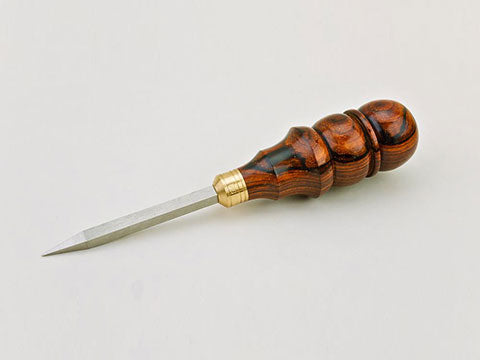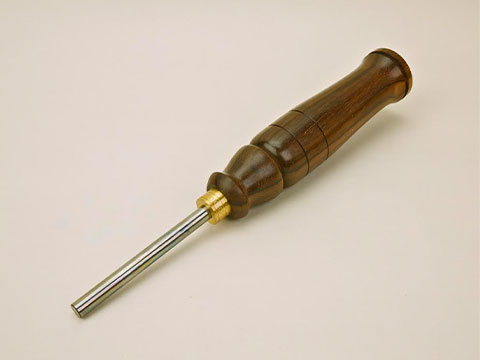How to Maintain
How to Maintain
Handle and Blade Care
The exotic wood handles on Czeck Edge Tools are finished with super blonde shellac mixed 5:1 with boiled linseed oil (BLO). Shellac provides some protection from continual shop use but is very susceptible to damage from water and beverages. The good news is that shellac is a very easily renewable finish and a few drops on a rag applied to the damaged or worn area can restore your tool's finish to like new condition.
Czeck Edge marking knive blades are made from O1 tool steel. O1 has marvelous qualities for tool use but rust resistance is unfortunately, not one of them. (The Bird Cage Awls are made from A2 tool steel and it shares almost the same rust susceptibility as 01.) A light coat of silicon free wax should be kept on the blade surfaces to form a durable barrier against moisture to prevent rust. Renaissance Wax is one that is recommended highly. In the event that rust does form, an abrasive eraser is an efficient method of rust removal. The Klingspor Sandflex Hand Block is the one recommended and will duplicate the satin finish applied to Czeck Edge blade surfaces.
Please note that the Carbide Super Kadet II and Bird Cage Awl have none of the blade rust concerns discussed above because their blades have almost zero carbon content. They are essentially maintenance free and should never require sharpening in normal use.
Sharpening Czeck Edge Carbon Steel Tools
Czeck Edge Marking Knives need to be kept sharp, but not atom splitting sharp. The main idea behind the use of a marking knife is to create a registration line for a chisel, handsaw or other appropriate tool. The more distinct the line, the better the cutting tool will find and keep it's mark. The marking knife should cut the wood fibers easily and neatly, without excessive penetration into the stock. Marking knives are not intended for stock removal so their sharpening protocol is not as critical nor as intense as the regimen followed for chisels and plane irons.
Periodic stropping with a leather strop will keep your Czeck Edge marking knife sharp for a good while. Check the edge by pushing it across the back of a finger nail every so often. If a little fuzz is created, you're good to go and if not, it's time to strop it. Charge the strop with a good purpose designed rouge such as Veritas Honing Compound. Several drops of mineral oil applied to the leather first will allow the compound to form a paste and penetrate the leather, assuring excellent adhesion. Find the bevel and with medium pressure, draw the edge smoothly away from you for the right edge and toward you for the left edge. About 4 – 6 strokes each way and your marking knife should be ready for work again.
Eventually, the edge will need to be restored and a more intense abrasive will be necessary. An oil stone in the 1,000 grit range, an equivalent water stone, sandpaper (on a substrate such as glass) may be used. The method is much like that used for stropping and again a free hand technique must be employed. We have found that a https://www.czeckedge.com/collections/sharpening accomplishes this task in a much more user friendly fashion. The Mini-Hone can be held much closer to the eye and the bevel can be seen, set and maintained very easily while the blade is drawn across it's surface. A few strokes and you'll be good to go.
Awls and Bird Cage Awls do not benefit much from stropping but it can be tried once or twice initially. What is really required is a solid surface sharpening media in the 1,000 grit range, just like that used for a marking knife. Awls can be pushed into the stone's surface as the blade is rotated, maintaining the conical point. A few strokes is all that is necessary. Awls can easily groove the surface of a stone so it's a good idea to use the edge of the stone for sharpening your awls. Birdcage awls should be free hand sharpened in the same manner you would for a narrow chisel. Find the bevel and push the point across the stone, 4- 6 times will do it. Again, the https://www.czeckedge.com/collections/sharpening will do this job for you in a more user friendly fashion. An round Awl cannot groove or damage its diamond coated surface.







